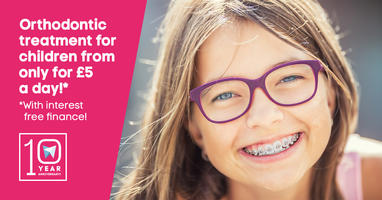Types of Braces
Pediatric orthodontics
Childhood is the best time to start orthodontic treatment, as the bones of the jaw are still growing and the newly erupted teeth can still be set easily into a new alignment easily. The jaw bones reach their final state around the age of 14, which means that the general patterns are visible and easily reversible before this point.
Once the growth of the jawbones is complete, it is more complicated to resolve bite discrepancies, crowding or spacing, so it is essential to have the treatment started in an early age.
Pre-orthodontic trainers

You might not think that some childhood habits can lead to dysfunctions in your child’s bite, thus risking the normal forming of the jawbones. Thumb sucking, mouth breathing or tongue thrusts can all lead to bite discrepancies, crowding or spacing.
There is a treatment option for our young ones even before the permanent teeth erupt.
Orthodontic trainers are prefabricated dental positioners, designed by a digital software. They serve to provide myofunctional therapy by helping your child to develop the right swallowing, chewing and tongue positioning habits.
Trainers can be used as a pre-orthodontic treatment from the age of 6, while the teeth are still in the changing phase.
This appliance will help future orthodontic treatment by making it less complex and decreasing the need for extractions. Trainers are to be worn at least 2-3 hours a day, which requires cooperation from the parents’ and the child’s side as well. Monthly checkups are essential here as well, to monitor the progress of the treatment.
Arch expanders
Should your child have crowding or crossbite, the orthodontist might suggest a palatal expander. By looking at pictures, you might find this appliance intimidating, but don’t worry, it will do the magic without too much hassle!
Arch expanders are the most commonly used orthodontic appliances in child orthodontry, which can help the teeth to align back to their normal position by creating a wider arch.
The appliance is attached to the lingual side of the upper arch, thus applying pressure from the inside out.
Your child might experience some initial discomfort right after the expander is placed, but the whole treatment is relatively painless.
Patients report some pressure on the palate and speech difficulties as well, but don’t worry, these fade away after a couple of days.
One of the most visible signs that the expander is working well, is the appearance of a gap between the upper first incisors. The space appears because the appliance pushes the two sides of the palate into opposite directions. Once you stop activating the expander, the space will be closed spontaneously.
Before the treatment starts, the orthodontist will decide how much expansion is necessary. Once the desired result is achieved, they will advise on how long the retainer should be worn to stabilize the results. This may range between a few months to the equivalent length of the treatment.
Orthodontic treatment for children only for £5 a day!
*With interest free finance
The offer is valid until withdrawal.
Get in touch
Book an appointment or ask a question
-
The Many Benetfits of Orthodontic Treatment
- 2021. January 26
-
Thinking Of Changing Your Orthodontist?
- 2020. January 23
-
Caring For Your Braces
- 2020. January 06
-
Does My Child Need Braces?
- 2019. December 19
-
A Little History Of Orthodontics
- 2019. December 09

